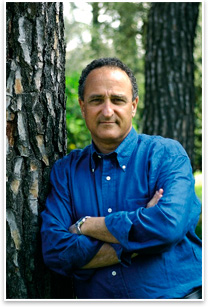| Giancarlo Alhadeff, FAIA
by John Gendall
Summary: AIArchitect spoke with Giancarlo Alhadeff, FAIA, about his international practice and the importance he attaches to maintaining close ties with AIA.
Though Giancarlo Alhadeff, FAIA, runs an architectural office in
Milan, Italy, his practice remains untethered to any given city.
With ongoing commissions in Japan, Turkey, Egypt, and Italy, his
three- to five-person firm is at work on projects on scales ranging
from small residential renovations to larger commercial buildings.
From abroad, he remains closely involved with the AIA, and in 2008
he was elected to the College of Fellows in part for his important
contributions to the professional organization’s international
presence.
For Alhadeff, life abroad is nothing new. Born in Egypt, he lived
in Japan and Europe before going to Massachusetts to study art history
at Harvard. Since then, the multilingual architect has maintained
a global life and practice. After earning his undergraduate degree,
Alhadeff, keeping brisk momentum, moved down to New York to study
architecture at Columbia, where he earned an MArch in 1975. After
graduating, he worked for a few New York firms, including Mitchell/Giurgola,
Polshek, and KPF while pursuing his registration.
“I became registered fairly quickly, and once I became registered, I then joined the AIA fairly quickly,” Alhadeff says. He had won an AIA medal for student work at Columbia, so he had become connected with the organization early.
Once he became licensed, he established his own practice in New York. Though the young firm picked up work, the timing turned out not to be ideal. “At the time, we were in the midst of another recession, so since the market was slow in the States, I decided to go to Europe,” he recalls. There, he established a firm in Milan.
Having joined the AIA early in his career, Alhadeff wanted to continue his involvement with the organization even while in Italy. So in 1994, he set out to make that happen. “A few friends and colleagues and I set up the AIA Continental Chapter,” he explains. “It’s been very beneficial to maintain a connection to the larger professional group.”
After helping found the component, Alhadeff continued in important leadership roles. In 1999, he served president of AIA Continental Europe, and, from 2005-2008, he was the AIA liaison to the Architects Council of Europe.
“The AIA provides a lot of collegiality. It enables us to meet other professionals in other countries,” he says. The group holds conferences in different cities around the year, providing a regular venue to meet. Citing the presentation of issues ranging from sustainability practices to emerging software, Alhadeff considers the meetings as integral to his practice. “There’s a tremendous exchange of ideas that happens there,” he says. “It’s very useful to be exposed to that kind of thinking.”
“When you have opportunities to meet clients from other countries, it’s very helpful,” he explains. “There is a level of professionalism to the organization where it sets standards of contract documents and practices for how to conduct a business. I’m a designer,” he adds. “I don’t spend too much time on administrative things. The organization is quite useful.”
“In an international market, the organization helps with issues like contracts. When I was working on a project in France, I found out through the AIA network that I could sign the drawings, and I would not have known this otherwise,” Alhadeff explains.
“In Italy, we are affected by the recession, so this is a difficult time. But,” he adds, “our highs and lows are not quite as high and not quite as low as they are in the U.S.” In his estimation, his practice’s globalism is very much an asset. “My practice is spread out over several markets, which should help me dodge the recession bullet.”
Importantly, it’s not just his practice that is crossing borders. “I and other architects in Europe,” Alhadeff says, “are trying to find ways in which the AIA can reach out to the global community.” |


